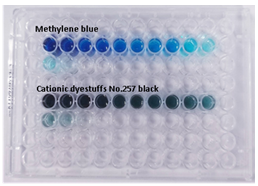Natural Nanoporous Filter Material as a New High-Efficiency Natural Adsorbent to Remove Textile Dyes
DOI:
https://doi.org/10.46604/peti.2020.4668Keywords:
natural nanoporous filter, textile wastewater, adsorption test, mathematic simulation modelAbstract
The objective of this paper is to perform the innovation design of removing most textile dyes that are harmful to the environment and might induce cancer. However, many methodologies had been developed for various chemical and physical processes to remove different dyes, such as ozone oxidation, electrochemical methods, chemical coagulation, hypochlorite oxidation, and adsorption to remove dyes from wastewater. A novel nanoporous filter methodology and mathematic simulations for adsorption were established as an effective medium for removing dyes from wastewater which was compared to other expensive treatments. The different concentrations of the dye liquid are used as a tester, and the different concentrations of nanoporous adsorbent were added in a uniform distribution and were tested with different time courses and under different temperatures. The final readings were measured by a spectrophotometer and fit into a mathematic model. The result indicates that this nanoporous and natural adsorbents are very good at cleaning the dyes in this system. The fit-in mathematic models could be applied in these tests which can be used in the industrial conditions for a low cost without secondary dye pollutions.
References
M. Mohammed, A. Shitu, and A. Ibrahim, “Removal of methylene blue using low cost adsorbent: a review,” Research Journal of Chemical Sciences, vol. 4, no. 1, pp. 91-102, January 2014.
R. Kant, “Textile dyeing industry an environmental hazard,” Natural Science, vol. 4, no. 1, pp. 22-26, December 2011.
M. S. Chiou, P. Y. Ho, and H. Y. Li, “Adsorption of anionic dyes in acid solutions using chemically cross-linked chitosan beads,” Dyes Pigments, vol. 60, no. 1, pp. 69-84, January 2004.
M. C. J. D. Shih and W. Treatment, “Kinetics of the batch adsorption of methylene blue from aqueous solutions onto rice husk: effect of acid-modified process and dye concentration,” Desalination Water Treatment, vol. 37, no. 1-3, pp. 200-214, January 2012.
A. Demirbas, “Agricultural based activated carbons for the removal of dyes from aqueous solutions: a review,” Journal of Hazardous Materials, vol. 167, no. 1-3, pp. 1-9, Auguest 2009.
S. Rakass, A. Mohmoud, H. Oudghiri Hassani, M. Abboudi, F. Kooli, and F. Al Wadaani, “Modified nigella sativa seeds as a novel efficient natural adsorbent for removal of methylene blue dye,” Molecules, vol. 23, no. 8, pp. 1950, Auguest 2018.
J. Mo, Q. Yang, N. Zhang, W. Zhang, Y. Zheng, and Z. Zhang, “A review on agro-industrial waste (AIW) derived adsorbents for water and wastewater treatment,” Journal of Environmental Management, vol. 227, no. 1, pp. 395-405, December 2018.
B. H. Tan, T. T. Teng, and A. M. Omar, “Removal of dyes and industrial dye wastes by magnesium chloride,” Water Research, vol. 34, no. 2, pp. 597-601, February 2000.
K. P. Singh, S. Gupta, A. K. Singh, and S. Sinha, “ Optimizing adsorption of crystal violet dye from water by magnetic nanocomposite using response surface modeling approach,” Journal of Hazardous Materials, vol. 186, no. 2-3, pp. 1462-1473, February 2011.
V. C. Srivastava, I. D. Mall, and I. M. J. C. E. J. Mishra, “Adsorption thermodynamics and isosteric heat of adsorption of toxic metal ions onto bagasse fly ash (BFA) and rice husk ash (RHA),” Chemical Engineering Journal, vol. 132, no. 1-3, pp. 267-278, Auguest 2007.
J. O. Amode, J. H. Santos, Z. M. Alam, A. H. Mirza, and C. C. Mei, “Adsorption of methylene blue from aqueous solution using untreated and treated (Metroxylon spp.) waste adsorbent: equilibrium and kinetics studies,” International Journal of Industrial Chemistry, vol. 7, no. 3, pp. 333-345, September 2016.
S. Tahir and N. Rauf, “Removal of a cationic dye from aqueous solutions by adsorption onto bentonite clay,” Chemosphere, vol. 63, no. 11, pp. 1842-1848, June 2006.
C. Y. Kuo and L. Hsiao-Han, “The study of natural nano-composite filter for industrial wastewater treatment,” Proceedings of Engineering and Technology Innovation, vol. 10, p. 42, December 2018.
M. C. Ncibi, B. Mahjoub, and M. Seffen, “Kinetic and equilibrium studies of methylene blue biosorption by posidonia oceanica (L.) fibres,” Journal of Hazardous Materials, vol. 139, no. 2, pp. 280-285, January 2007.
Y. T. Huang, L. C. Lee, and M. C. Shih, “A Study on the pseudo-second-order kinetic equation for the adsorption of methylene blue onto nitric acid-treated rice husk: comparison of linear methods,” International Journal of Scientific Research Publications Desalination, vol. 8, no. 6, pp. 509-515, June 2018.
P. E. Meissner, G. Mandi, B. Coulibaly, S. Witte, T. Tapsoba, and U. Mansmann, et al., “Methylene blue for malaria in Africa: results from a dose-finding study in combination with chloroquine,” Malaria Journal, vol. 5, pp. 84, October 2006.
Y. Wong, Y. Szeto, W. Cheung, and G. McKay, “Equilibrium studies for acid dye adsorption onto chitosan,” Langmuir, vol. 19, no. 19, pp. 7888-7894, Auguest 2003.

Published
How to Cite
Issue
Section
License
Submission of a manuscript implies: that the work described has not been published before that it is not under consideration for publication elsewhere; that if and when the manuscript is accepted for publication. Authors can retain copyright of their article with no restrictions. Also, author can post the final, peer-reviewed manuscript version (postprint) to any repository or website.

Since Oct. 01, 2015, PETI will publish new articles with Creative Commons Attribution Non-Commercial License, under The Creative Commons Attribution Non-Commercial 4.0 International (CC BY-NC 4.0) License.
The Creative Commons Attribution Non-Commercial (CC-BY-NC) License permits use, distribution and reproduction in any medium, provided the original work is properly cited and is not used for commercial purposes







